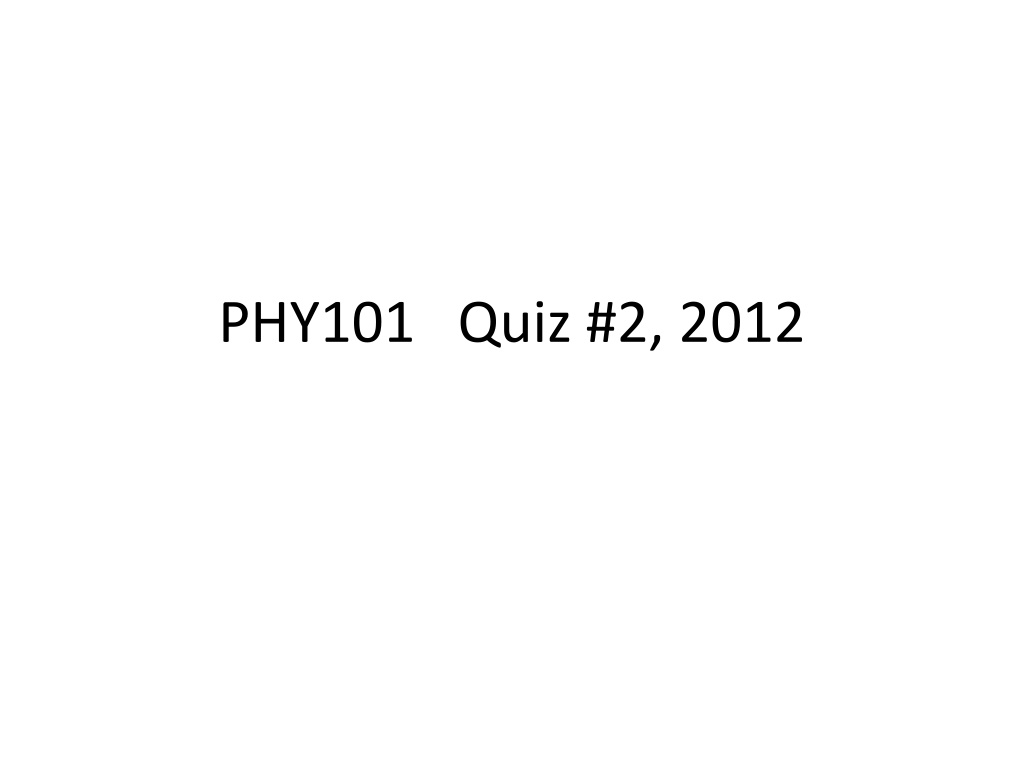Physics Quiz Questions with Solutions
Explore a selection of physics quiz questions from a 2012 exam, covering topics such as centripetal acceleration, friction, work done by forces, gravitational potential energy, projectile motion, and momentum changes. Test your understanding and knowledge of fundamental physics principles with detailed explanations for each question.
Download Presentation

Please find below an Image/Link to download the presentation.
The content on the website is provided AS IS for your information and personal use only. It may not be sold, licensed, or shared on other websites without obtaining consent from the author. Download presentation by click this link. If you encounter any issues during the download, it is possible that the publisher has removed the file from their server.
E N D
Presentation Transcript
1. A solar-powered car is traveling at constant speed around a circular track. What happens to the centripetal acceleration of the car if the speed is doubled? A) The centripetal acceleration remains the same. B) The centripetal acceleration increases by a factor of 2. C) The centripetal acceleration increases by a factor of 4. D) The centripetal acceleration is decreased by a factor of one- half. E) The centripetal acceleration is decreased by a factor of one- fourth. Ans: C SectionDef: Section 5-1 and 5-2
2. A car enters a horizontal, curved roadbed of radius 50 m. The coefficient of static friction between the tires and the roadbed is 0.20. What is the maximum speed with which the car can safely negotiate the unbanked curve? A) 5 m/s B) 10 m/s C) 20 m/s D) 40 m/s E) 100 m/s Ans: B SectionDef: Section 5-4
3. A constant force of 25 N is applied as shown to a block which undergoes a displacement of 7.5 m to the right along a frictionless surface while the force acts. What is the work done by the force? A) zero joules B) +94 J C) 94 J D) +160 J E) 160 J Ans: E SectionDef: Section 6-1 and 6-2
4. During the construction of a high rise building, 40-kg block is vertically lifted 20 meters from the surface of the earth. To one significant figure, what is the change in the gravitational potential energy of the block? A) +800 J B) 800 J C) +8000 J D) 8000 J E) zero joules Ans: C SectionDef: Section 6-3 and 6-4
5. A pebble rolls off the roof of Science Hall and falls vertically. Just before it reaches the ground, the pebble's speed is 17 m/s. Neglect air resistance and determine the height of Science Hall. A) 42 m B) 33 m C) 26 m D) 21 m E) 15 m Ans: E SectionDef: Section 6-5
6. A 1.0-kg ball has a velocity of 12 m/s downward just before it strikes the ground and bounces up with a velocity of 12 m/s upward. What is the change in momentum of the ball? A) zero kg m/s B) 12 kg m/s, downward C) 12 kg m/s, upward D) 24 kg m/s, downward E) 24 kg m/s, upward Ans: E SectionDef: Section 7-1
7. A sled of mass m is coasting on the icy surface of a frozen river. While it is passing under a bridge, a package of equal mass m is dropped straight down and lands on the sled (without causing any damage). The sled plus the added load then continue along the original line of motion. How does the kinetic energy of the (sled + load) compare with the original kinetic energy of the sled? A) It is 1/4 the original kinetic energy of the sled. B) It is 1/2 the original kinetic energy of the sled. C) It is 3/4 the original kinetic energy of the sled. D) It is the same as the original kinetic energy of the sled. E) It is twice the original kinetic energy of the sled. Ans: B SectionDef: Section 7-2

























